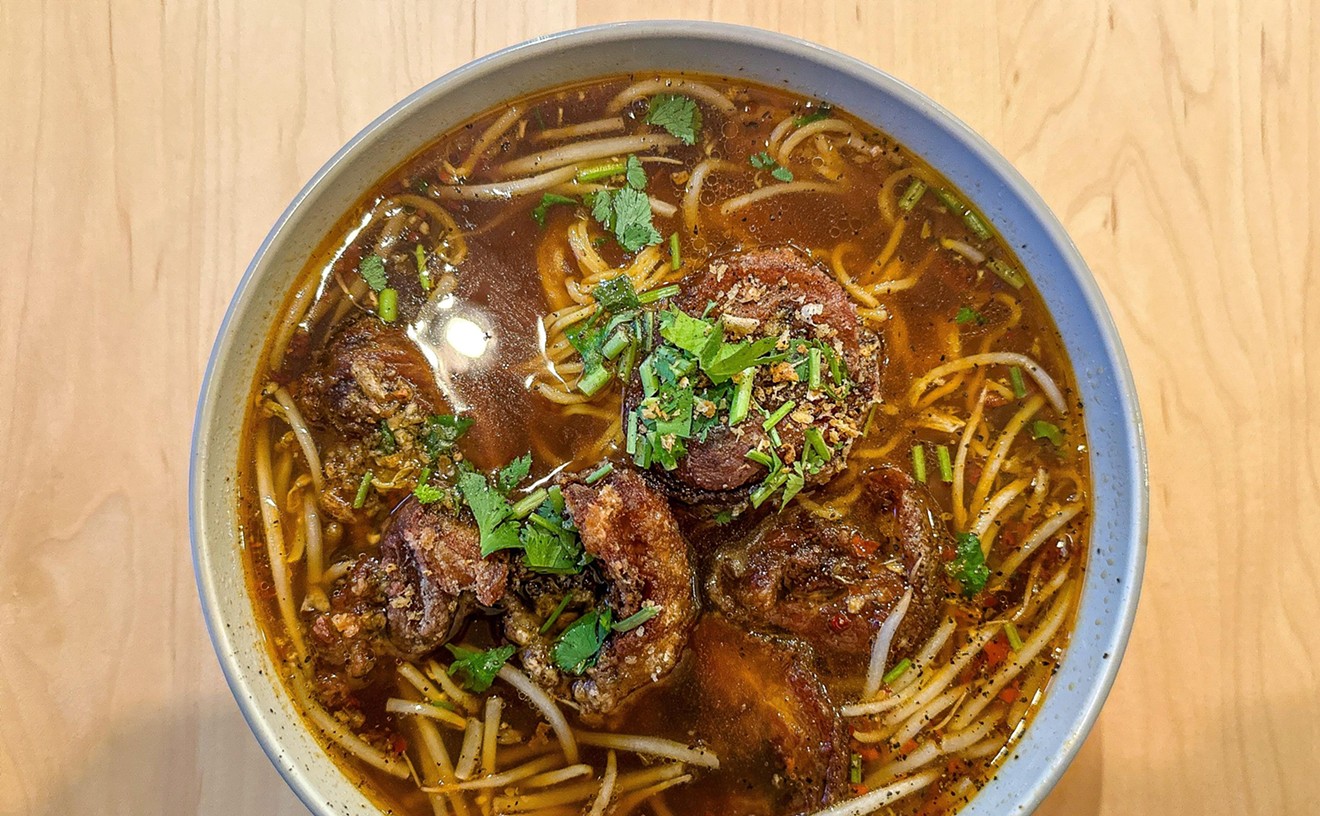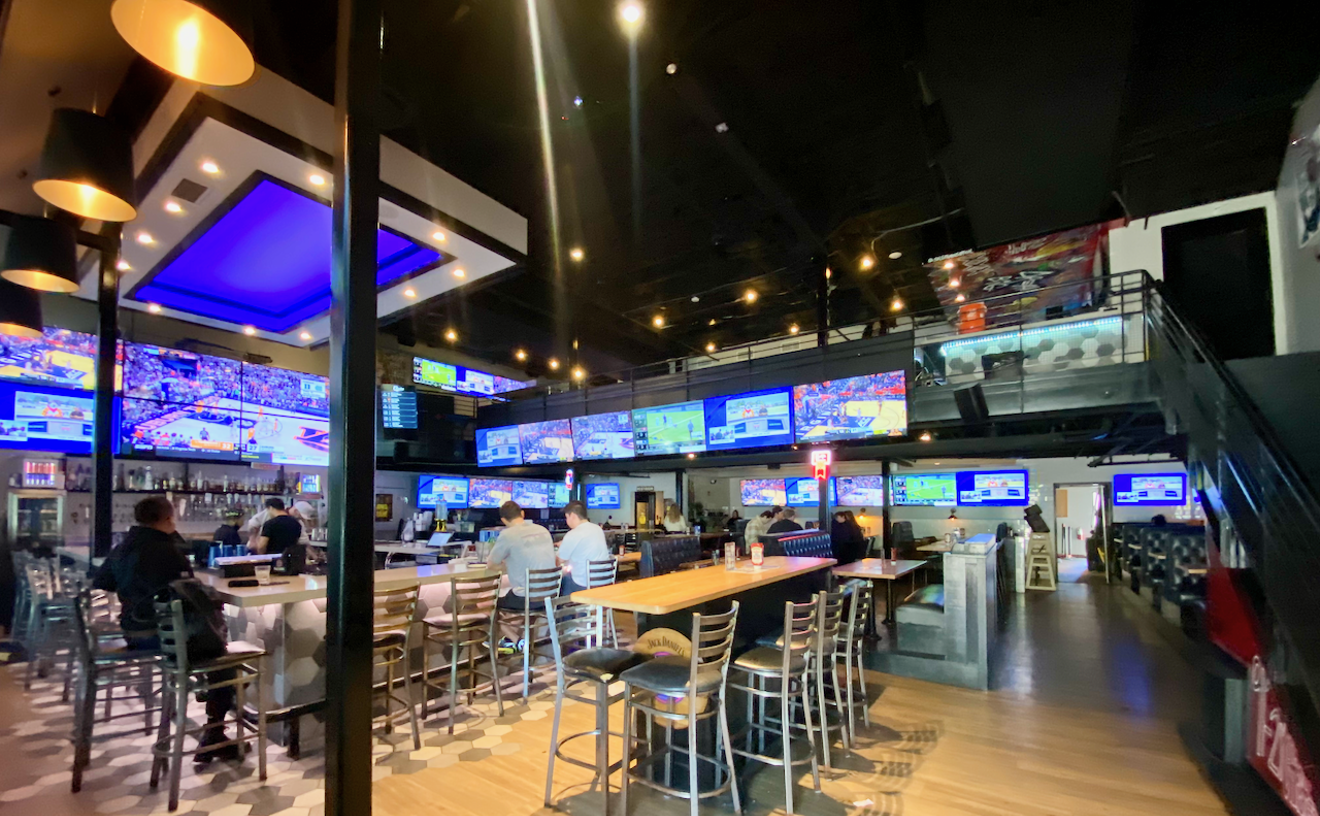The Burning Question crew chooses not to follow false prophets. For yea, we say unto thee, chef Russell Hodges preaches the apocalyptic vision America needs in these dark times. An example of a fiery sermon from his pulpit at Iris: "These are the last days. In the last days, you will see a chipotle barbecued Peruvian potato."
"That's in the Bible," he assures us.
OK, so it's not really fire and brimstone material. No dogs and cats living together, no Austrian-born steroided-up ass-grabber running for president. We're not even sure if the good book mentions Tex-Mex flavors. His invocation, however, reflects a rather bizarre culinary trend: menu items that seem inappropriate to a restaurant's dominant theme.
We know you've encountered this. Samba Room's Caribbean menu, for example, features sushi. Not jerk sushi, mind you, but plain old raw fish rolled in rice and seaweed, mon. Chinese buffets serve tamales. Cantina Laredo counters with Danish baby back ribs. And Paris Vendome, which we think is just known as Paris nowadays--you know, to avoid any association with France--introduced Tex-Mex items.
"The new trend is a Mexican or Asian connection," acknowledges Joel Harloff, chef at Landmark Restaurant.
Yes, but why do restaurants serve incongruous menu items?
To find out, the Burning Question crew visited Canary Café, Oceanaire, Hibiscus and The Loon...the latter merely because we needed a few stiff, palate-cleansing drinks before starting our research. Hibiscus happens to sit in between The Loon and the other establishments--a good spot for a refill, in other words.
Canary Cafe is a Mediterranean venue serving a lunchtime combination of Middle Eastern and Japanese dishes. "I didn't want to do it," claims chef-owner Mansour Gorji, perhaps fearing the wrath of a vengeful God, "but people kept coming in requesting it." His location once housed Yoshi, a sushi place. "The Japanese thing at lunch, you have no idea how many people come through." We dined on hummus, dolmas and sushi, capped by some Peruvian beer and Indian wine. At Oceanaire, the city's best seafood place, we tried steak and Boston baked black-eyed peas. Ordering beef at a seafood restaurant "makes about as much sense as going to a proctologist to get a tooth pulled," according to former Dallas drinking man and now Southlake elder statesman Mike Cantrell. It wasn't bad, though--a bit overcooked, but Oceanaire only sells about eight or nine prime New York strips each week and Chef Marc Morton explains "it's a different cook time, so the challenge is pulling the brakes on them [the line cooks]."
The black-eyed peas were brilliant.
It makes sense for some kitchens to kick out a few atypical dishes. Steak houses must serve sea bass and lobster to account for tables where one or two people prefer to avoid clogged arteries. Fish places, such as Oceanaire, sell red meat for the same reason, except for the part about clogged arteries.
"Everybody who walks through that door, you want to make them happy," Morton says.
Sometimes restaurants deviate from the theme because chefs yearn to try a different recipe. "You could call it an inner burst of creativity that needs to get out," Harloff says, although he personally refrains from stretching Landmark's menu too far because, as he puts it, the Burning Question crew might drop by for an explanation, and finish off his liquor supply in the process. Kent Rathbun's fusion menu at Abacus and Marc Cassel's famous "collision cuisine" now featured at Dragonfly represent successful examples of cross-cultural creativity. Gorji spent years traveling to kitchens around the world, learning different ingredients and cooking styles. He manages to pull off not only the lunch mix, but also schedules regular world "tours" at Canary Café, combining food, wine and music from three countries in one meal. Yet, as Morton cautions, "if you try to do too much, you set yourself up for failure."
People expect Rathbun to bend the rules. They visit Tramontana, on the other hand, for dishes prepared in a classic French style. "I did a foie gras and duck spring roll and didn't sell a one," says James Neel, Tramontana's chef-owner. "I changed it to a crepe, and it's selling."
Here's where we stand so far: nothing wrong with a few items to placate, say, the one person at a table of six who won't touch seafood. Ditto with chefs expressing a bit of creativity once in awhile. "Sometimes an item starts as a special and then catches on," notes Nick Badovinus of Hibiscus, Cuba Libre and Fireside Pies. "Other times it's more calculating."
Ah, yes. There's a third reason restaurants add incongruous items to their menus.
When once red-hot venues experience a prolonged revenue slump, they too often rely on gimmicks to lure gullible patrons back through the doors. Hence sushi at Samba Room and the Tex-Mex incursion at Paris Whatever. Restaurants struggling to regain their status place faith in the almighty California roll or the holy burrito. "They pick out the hottest new ingredients, look for the buzzwords and put them on the menu," Hodges complains. He's apparently never tried traditional Jamaican sushi in Kingston, served since colonial times to the curious sound of a kettle drum. Guess he's never bought taquitos from a polite street vendor in Paris, either. "It doesn't make sense," he continues. "Food should have a timeless quality."
So there is a downside.
Well, that wraps up this week's Burning Question. Scan a menu and something seems out of place, just work the problem. If you're sitting in a chef-owned place with a steady following, they're probably flexing a bit. At a steak or seafood restaurant, it's something they gotta do. Otherwise, it's a mark of desperation.
Remember, Hodges concludes, "just because we have the technology to grill and smoke a strawberry, why should we?"
I Caucasians 5:19, we think...










